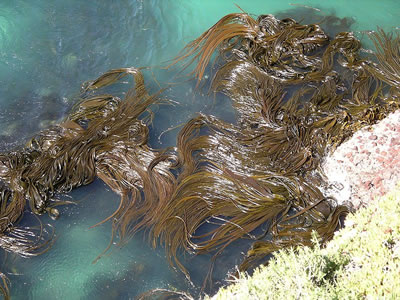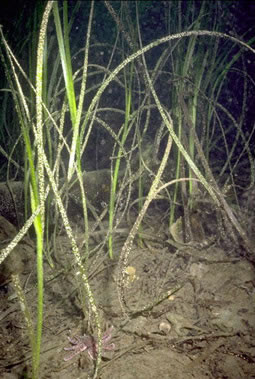A large amount of light can reach the bottom of the shallow waters along the continental shelf.
Here, there are abundant growths of seaweed.
Brown algae (Phaeophyceae), including kelp, are the most common type of seaweed at middle and high latitudes.
Kelp may grow over 100 feet high.
 Halophytes, seed plants that are naturally adapted to a marine environment grow here.
Halophytes, seed plants that are naturally adapted to a marine environment grow here.
These may include eelgrass (Zostera marina).
Few plants will grow on a sandy shore because the bottom is too unstable for them.
Mollusks, crustaceans and annelid worms will burrow into the sand.
 Some fishes, such as flounder, bury themselves - either partly or completely - in the sand.
Some fishes, such as flounder, bury themselves - either partly or completely - in the sand.
If the bottom of the shore is muddy, scallops, sea cucumbers and crabs will burrow into the mud.
Rocky shores usually have strong currents.
Many animals, such as barnacles and mussels, attach themselves to one spot.
Animals that have no shells hide in spaces between the rocks.
In the intertidal zone - the area between the high and low tide marks, also known as the littoral zone - twice a day, living things are submerged in salt water and exposed to the air - possibly to hot sun or freezing winds.
These organisms are also pounded by the waves themselves.
On sandy coasts, life here is limited to burrowing creatures, such crabs, or creatures that can scuttle over the sand.
On rocky coasts, brown algae cling to rocks. A gelatinous coating prevents them from drying out in the sun.
These algae protect and support other organisms.
Snails, barnacles, limpets and chitons cling to rocks and seaweeds.
They shut themselves tightly whenever they are exposed to air.
The spray zone (also known as the splash zone, supratidal zone or supralittoral zone) is the area above the intertidal zone.
Here land plants that can resist the effects of salt spray spread as far as the waves allow.
Shore birds forage in the debris left by the ocean.
Some crustaceans hide in the debris.